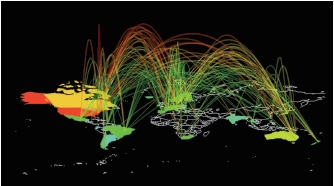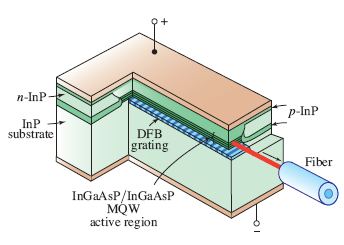
Credits: 3 hours
Detailed Description:
This course is an introduction to the principles of optical fiber communication systems. The course covers three topics: 1) The optical fiber as a transmission channel. 2) Optoelectronic devices used in transmitters, receivers, and multiplexers. 3) Design of the overall communication system and assessment of its performance. In part 1, step-index and graded-index multimode and single-mode optical fibers are described and their attenuation and dispersion characteristics are determined. The transfer function of the fiber system is determined. Part 2 introduces the basic principles of interaction of light with semiconductor materials, including absorption and electroluminescence. Light emitting diodes, laser diodes, and photodiodes are introduced as the basic components of optical transmitters and receivers. Semiconductor and fiber optical amplifiers are also introduced. Part 3 deals with the design of the digital fiber communication system, including derivation of the bit error rates for attenuation- and dispersion-limited systems and determination of the maximum data rates possible for a given length. Introductions to wavelength-division multiplexing (WDM) and optical fiber networks are also provided.

Prerequisites: EEL 4440 Optical Engineering
List of Topics:
- The fiber as a communication link:
- Planar optical waveguides. Waveguide modes.
- Step- and graded-index optical fibers. Multimode and single mode fibers.
- Attenuation. Material and modal dispersion
- Broadening of optical pulses in fibers
- Optoelectronics of transmitters and receivers:
- Interaction of light with semiconductor materials. Absorption and electroluminescence.
- Optoelectronics: Semiconductor light sources (Light emitting diodes and laser diodes) and photodetectors (PIN photodiodes and avalanche photodiodes)
- Semiconductor and fiber optical amplifiers
- The communication system
- Digital fiber communication systems. Bit error rates for attenuation- and dispersion-limited systems.
- Maximum data rates achievable for a given fiber length.
- Wavelength-division multiplexing (WDM).
- Optical fiber networks
Learning Outcomes:
Upon completing this course, the students will:
- Understand how optical fibers guide light, including the concepts of guided modes and group velocity.
- Know how to compute the attenuation and pulse broadening encountered when optical pulses at a given wavelength travel in long fibers.
- Know the operational principles of light emitting diodes and laser diodes and their distinction
- Know the operational principles and the limitations of photodiodes and avalanche photodiodes
- Understand the basics of optical modulation and multiplexing
- Be able to design a fiber link of given length operating at a given wavelength, and at a prescribed bit error rate by use of optical repeaters
- Acquire an integrated view of engineering by seeing the fundamental analogies between electrical and optical communication systems
References:
Required Textbook:
- Optical Fiber Communications, 4th Edition G. Keiser, McGraw-Hill
Suggested Textbooks:
- Introduction to Optical Fiber Communication Systems, W. Jones, Jr., Oxford University Press.
- Fiber-Optic Communication Systems, G. Agrawal, Wiley.
- Fundamentals of Photonics, 2nd Edition, B. Saleh and M. Teich, Wiley.
Assessment
- Homework (20%)
- Midterm exam (40%)
- Final exam (40%)
